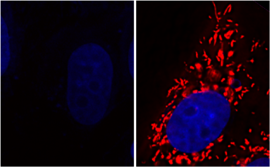D-lactate and glycolate
Anthony Hyman and Teymuras Kurzchalia, two researchers from the Max Planck Institute for Molecular Cell Biology and Genetics in Dresden have discovered that Parkinsonian nerve cells of the substantia Nigra are characterized by the addition of two natural substances, glycolic acid and a certain lactic acid Lactate) can again be brought to full functional capability.
On the one hand, they have investigated dopamine neurons from cell cultures of Parkinson's disease with the gene defect DJ-1, which reduces the natural production of D-lactate and glycolate. In this way, the mitochondria of the cells responsible for the energy production are permanently damaged and eventually die, leading to the death of the nerve cell as a whole.

Source: MPI-CBG
On the other hand, they have studied dopamine neurons poisoned with the herbicide paraquat. Paraquat is known to cause Parkinson's disease. These cells also show a decreasing performance of the mitochondria up to the time of the tsuno.
The extraordinarily astonishing result after addition of D-lactate or glycolate: the mitochondria of the damaged cells recover again and the cells return to their original performance overall. The addition of one of the two active ingredients is sufficient.
The researchers have not yet been able to decipher the exact mechanism of this cell healing. This is her next goal.
It is clear, however, that for the first time two active substances have been found which can cure the dopamine neurons damaged in the course of Parkinson's disease. Already completely dead dopamine neurons can not be restored in this way.
The targeted drug application of these drugs would potentially bring Parkinson's disease to a standstill and possibly provide a slight improvement by rescuing dopamine neurons that are already damaged but still alive. For the restoration of the complete dopamine production, for example, cell replacement therapies would have to be used.
If further research confirms the efficacy of D-lactate or glycolate for the rescue of damaged dopamine neurons, these two substances would also be ideal for Parkinson's disease prevention.
Furthermore, two very important findings are found: D-lactate and glycolate are present in ordinary foods and therefore do not require authorization as a medicament. Furthermore, the researchers have found that D-lactate and / or glycolate taken up with the diet is absorbed into the blood via the digestive tract, overcomes the blood-brain barrier and thus becomes available in the brain.
D-lactate is a so-called left-turning lactic acid produced by certain yogurt bacteria (lactobacillus bulgaricus). Virtually all commercially available yoghurts, however, use other yogurt bacteria, such as lactobacillus bifidus and lactobacillus acidophilus, which produce the right-handed lactic acid, which is generally regarded as healthy. Some yoghurts contain both left- and right-turning lactic acid, but this is not declared on the packaging and may change at any time. Yoghurt, which has hitherto been commercially available, is thus a de facto source of D-lactate.
Glycolate is increasingly found in certain immature fruit varieties, including immature plums. It is, however, unclear how much immature fruit should be consumed in order to reach a relevant concentration of glycolate in the brain.
The researchers have therefore announced to develop a special Parkinson's yogurt with a high content of D-lactate and bring it to the market.
Sources:
- Original article in Biology Open (July 2014)
- Publications of the Max-Planck-Gesellschaft and the MPI-CBG
- Press releases in Deutsch and English
